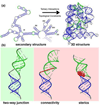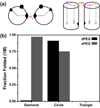Topological constraints: using RNA secondary structure to model 3D conformation, folding pathways, and dynamic adaptation
- PMID: 21497083
- PMCID: PMC3319143
- DOI: 10.1016/j.sbi.2011.03.009
Topological constraints: using RNA secondary structure to model 3D conformation, folding pathways, and dynamic adaptation
Abstract
Accompanying recent advances in determining RNA secondary structure is the growing appreciation for the importance of relatively simple topological constraints, encoded at the secondary structure level, in defining the overall architecture, folding pathways, and dynamic adaptability of RNA. A new view is emerging in which tertiary interactions do not define RNA 3D structure, but rather, help select specific conformers from an already narrow, topologically pre-defined conformational distribution. Studies are providing fundamental insights into the nature of these topological constraints, how they are encoded by the RNA secondary structure, and how they interplay with other interactions, breathing new meaning to RNA secondary structure. New approaches have been developed that take advantage of topological constraints in determining RNA backbone conformation based on secondary structure, and a limited set of other, easily accessible constraints. Topological constraints are also providing a much-needed framework for rationalizing and describing RNA dynamics and structural adaptation. Finally, studies suggest that topological constraints may play important roles in steering RNA folding pathways. Here, we review recent advances in our understanding of topological constraints encoded by the RNA secondary structure.
Copyright © 2011 Elsevier Ltd. All rights reserved.
Figures






Similar articles
-
Topological constraints are major determinants of tRNA tertiary structure and dynamics and provide basis for tertiary folding cooperativity.Nucleic Acids Res. 2014 Oct;42(18):11792-804. doi: 10.1093/nar/gku807. Epub 2014 Sep 12. Nucleic Acids Res. 2014. PMID: 25217593 Free PMC article.
-
Coarse grained models reveal essential contributions of topological constraints to the conformational free energy of RNA bulges.J Phys Chem B. 2014 Mar 13;118(10):2615-27. doi: 10.1021/jp411478x. Epub 2014 Mar 3. J Phys Chem B. 2014. PMID: 24547945 Free PMC article.
-
New insights into the fundamental role of topological constraints as a determinant of two-way junction conformation.Nucleic Acids Res. 2012 Jan;40(2):892-904. doi: 10.1093/nar/gkr751. Epub 2011 Sep 21. Nucleic Acids Res. 2012. PMID: 21937512 Free PMC article.
-
Modeling RNA topological structures using small angle X-ray scattering.Methods. 2016 Jul 1;103:18-24. doi: 10.1016/j.ymeth.2016.04.015. Epub 2016 Jun 2. Methods. 2016. PMID: 27090001 Review.
-
Structures of helical junctions in nucleic acids.Q Rev Biophys. 2000 May;33(2):109-59. doi: 10.1017/s0033583500003590. Q Rev Biophys. 2000. PMID: 11131562 Review.
Cited by
-
19 F NMR-Based Fragment Screening for 14 Different Biologically Active RNAs and 10 DNA and Protein Counter-Screens.Chembiochem. 2021 Jan 15;22(2):423-433. doi: 10.1002/cbic.202000476. Epub 2020 Sep 25. Chembiochem. 2021. PMID: 32794266 Free PMC article.
-
Long non-coding subgenomic flavivirus RNAs have extended 3D structures and are flexible in solution.EMBO Rep. 2019 Nov 5;20(11):e47016. doi: 10.15252/embr.201847016. Epub 2019 Sep 10. EMBO Rep. 2019. PMID: 31502753 Free PMC article.
-
How the Conformations of an Internal Junction Contribute to Fold an RNA Domain.J Phys Chem B. 2018 Dec 13;122(49):11363-11372. doi: 10.1021/acs.jpcb.8b07262. Epub 2018 Oct 17. J Phys Chem B. 2018. PMID: 30285445 Free PMC article.
-
Functional complexity and regulation through RNA dynamics.Nature. 2012 Feb 15;482(7385):322-30. doi: 10.1038/nature10885. Nature. 2012. PMID: 22337051 Free PMC article. Review.
-
Increasing the length of poly-pyrimidine bulges broadens RNA conformational ensembles with minimal impact on stacking energetics.RNA. 2018 Oct;24(10):1363-1376. doi: 10.1261/rna.066258.118. Epub 2018 Jul 16. RNA. 2018. PMID: 30012568 Free PMC article.
References
-
- Murthy VL, Srinivasan R, Draper DE, Rose GD. A complete conformational map for RNA. J Mol Biol. 1999;291:313–327. - PubMed
-
- Musselman C, Pitt SW, Gulati K, Foster LL, Andricioaei I, Al-Hashimi HM. Impact of static and dynamic A-form heterogeneity on the determination of RNA global structural dynamics using NMR residual dipolar couplings. J Biomol NMR. 2006;36:235–249. - PubMed
-
- Riordan FA, Bhattacharyya A, McAteer S, Lilley DM. Kinking of RNA helices by bulged bases, and the structure of the human immunodeficiency virus transactivator response element. J Mol Biol. 1992;226:305–310. - PubMed
-
- Lilley DM. Structures of helical junctions in nucleic acids. Q Rev Biophys. 2000;33:109–159. - PubMed
Publication types
MeSH terms
Substances
Grants and funding
LinkOut - more resources
Full Text Sources
Other Literature Sources

